Diverse wildlife, including numerous bird species, thrive within the boundaries of the Old Dominion. Included in those numbers are eight species of woodpeckers, plus one vagrant species occasionally spotted here. One woodpecker species is also endangered, so infrequently spotted in the forests of Virginia, but occasional sightings have been made. Let’s take a look at woodpeckers in Virginia to find out where you can find them, which species you’ll spot, and how to bring them into your own backyard for beautiful displays.
Species of Woodpeckers in Virginia

At least nine species of woodpeckers in Virginia have been seen. A few are rare or rarely present, but others, like the Northern Flicker, come to the state often or live there year-round.
©abriggs21/iStock via Getty Images
In Virginia, you’ll find up to nine woodpecker species flying, nesting, and hunting insects and sap.
- Pileated woodpecker
- Hairy woodpecker
- Northern flicker
- Yellow-bellied sapsucker
- Red-bellied woodpecker
- Downy woodpecker
- Red-headed woodpecker
- Red-cockaded woodpecker
- Lewis’s woodpecker
Where to Look for Woodpeckers in Virginia
Virginia, with its woodlands, mountains, rivers, and other incredible natural resources, hosts numerous fabulous sites for spotting woodpeckers. Some of the best of these, though include:
- Your backyard, urban, suburban, or rural
- Shenandoah National Park
- Big Meadows
- Hawksbill Mountain
- Great Dismal Swamp National Wildlife Refuge
- Mason Neck State Park
- James River Park system
Pileated Woodpecker
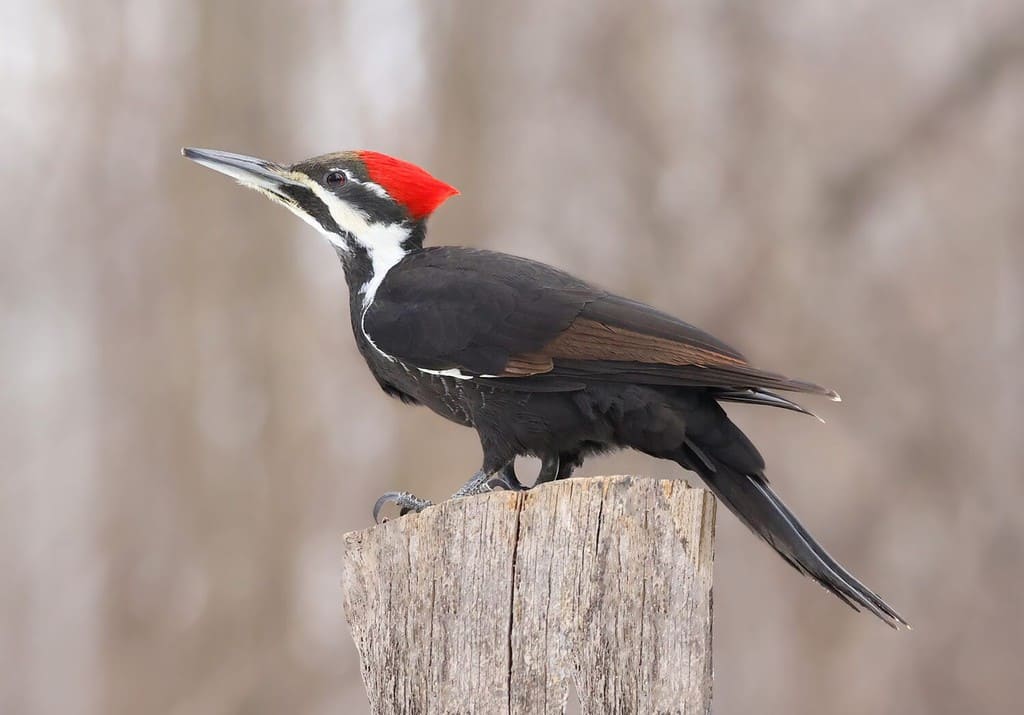
The gorgeous, large Pileated Woodpecker lives in Virginia year-round. Spot these birds in old forests and listen for their hammering to find them easily.
©Vlad G/Shutterstock.com
- Scientific name: Dryocopus pileatus
- Life span: 6 to 10 years
- Size: 16 to 19 inches
- Weight: 10 to 12 ounces
- Wingspan: 26-30 inches
- Status: Least concern
One of the largest species of woodpeckers in the United States, the pileated woodpecker may be spotted in Virginia year-round. The crow-sized birds bear bold white stripes and colorful red crests on their heads. They primarily live in old forests with loads of dead wood and fallen logs. They’re not commonly seen in backyards but they do occasionally land at suet feeders.
You’re most likely to spot these birds if you hear loud drumming nearby and small, broken dead trees drilled apart by their deep hammering. They prefer carpenter ants and insects but do enjoy fruit and other foods on occasion.
Hairy Woodpecker

Hairy woodpeckers have white bellies, with black backs, wings, and tail feathers. These adorable small birds live in Virginia year-round.
©sandymsj/Shutterstock.com
- Scientific name: Picoides villosus
- Life span: 5 to 10 years
- Size: 7 to 10 inches
- Weight: 1.5 ounces
- Wingspan: 16 to 20 inches
- Status: Least concern
Common birds, hairy woodpeckers in Virginia may be seen year-round. They love mature forests but often make their homes in parks, suburban areas, and open woodlands. These birds also frequently inhabit recently burned forests where foraging opportunities abound. Hairy woodpeckers use their long, strong bills to dig into bark and dead wood to find tasty wood-boring insects.
The hairy woodpecker looks like a larger version of the downy woodpecker with a black and white checkered plumage. White patches on their backs help distinguish them from the downies, though. Males also bear red patches on the backs of their heads.
You’ll entice these birds to your backyard with suet feeders and black sunflowers seeds.
Northern Flicker

You can spot northern flickers in Virginia any time of the year. They don’t mind the snow!
©DawnKey/iStock via Getty Images
- Scientific name: Colaptes auratus
- Life span: 5 to 8 years
- Size: 8 to 10 inches
- Weight: 2.5 ounces
- Wingspan: 14 to 16 inches
- Status: Least concern
While the name might not imply it, northern flickers are, indeed, woodpeckers. These birds are on the mid-range size of woodpeckers with pale brown plumage and colorful markings on their undersides. The slim heads, long tails, and slightly downward curved bills hint at their family associations. Northern flickers in the east have yellow coloring on their undersides in most cases, with western birds leaning more towards red coloring. So, occasionally you’ll wind up with an eastern yellow flicker with red underbellies and underwings.
Northern flickers prefer ground foraging to tree hunting for their insects, but they do perch in trees in upright branches. They don’t often use feeders in backyards but they will hang out in trees and use birdbaths.
Yellow-bellied Sapsucker

Yellow-belly sapsuckers are omnivores, and like their namesake, sapsuckers eat, live and breathe sap. Provide them with suet and other backyard feeders and you’re bound to see one sometime in Virginia.
©Glass and Nature/Shutterstock.com
- Scientific name: Sphyrapicus varius
- Life span: 5 to 8 years
- Size: 8 to 10 inches
- Weight: 2.5 ounces
- Wingspan: 14 to 16 inches
- Status: Least concern
During wintertime, you could spot a yellow-bellied sapsucker in Virginia. The birds breed elsewhere so they’re not the most common winter visitors, but they can still be found fairly frequently in the state. Look for rows of tiny, neatly space holes in trees to find them.
The yellow-bellied sapsucker has a reddish crown and throat, black and white bars and flecks on their wings, tails, and bodies, and have straight bills and long wings. The beautiful birds are smaller than hairy woodpeckers but larger than downy woodpeckers, landing them at about the size of a large robin.
Red-bellied Woodpecker
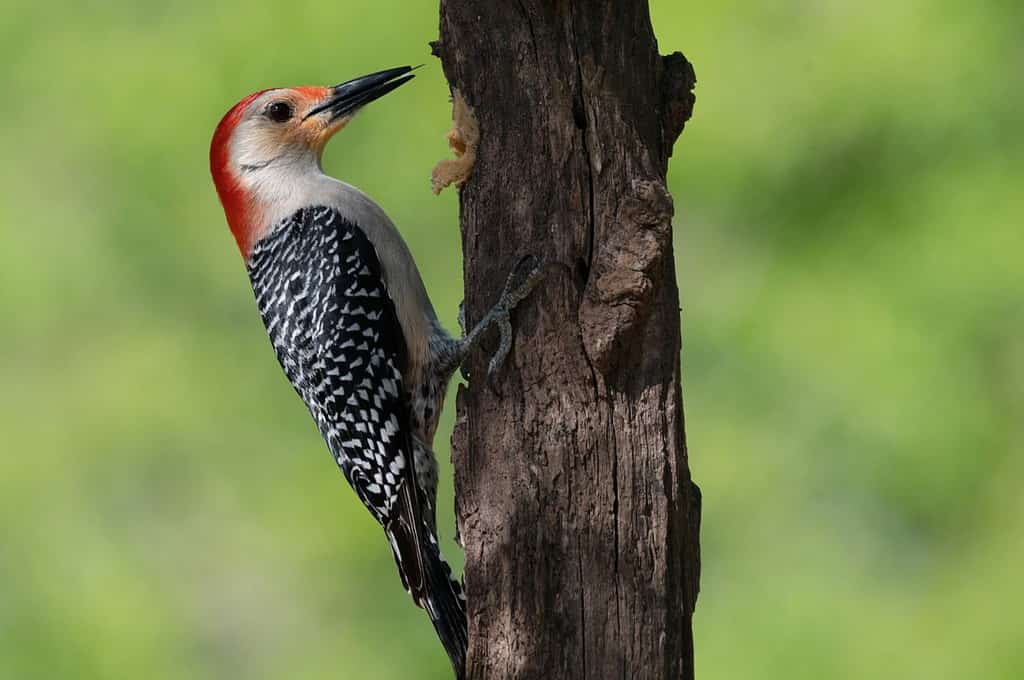
The distinctive looking red-bellied woodpecker bears white stripes on their backs, bright red heads and necks, and the signature red-orange bellies earning them their names. You can find these birds in Virginia year-round.
©Connie Moore/Shutterstock.com
- Scientific name: Melanerpes carolinus
- Life span: 10 to 12 years
- Size: 9 to 10 inches
- Weight: 2 to 3.2 ounces
- Wingspan: 14 to 17 inches
- Status: Least Concern
With pale, peach-colored underbellies, white stripes backs, and bright reds and necks, the red-bellied woodpecker in Virginia is fairly easy to identify. The beautiful bird lives in the state year-round, lurking in woodlands, forests, and groves near water. The adaptable birds love backyards and urban areas, too, so be sure to put out some berries, nuts, and seeds for them!
The unique woodpeckers use a distinctive, rolling call, frequently heard as loud and frequent in summer and springtime. For wintertime, put out peanuts and suet pats for them and you’ll likely have these beauties calling on your yard regularly for sustenance.
Downy Woodpecker

The small downy woodpeckers in Virginia are often mistaken for hairy woodpeckers. These beauties are smaller than their cousins, though, and have a few visual appearance differences otherwise, as well. For one, the males have small red patches on their caps.
©J Edwards Photography/Shutterstock.com
- Scientific name: Picoides pubescens
- Life span: 2 to 5 years
- Size: 6 to 7 inches
- Weight: 1 ounce
- Wingspan: 13 inches
- Status: Least concern
Often found year-round in Virginia, downy woodpeckers are one of the smallest in the Picoides family. This means sometimes they’re hard to spot without some concerted effort. The small birds come in between a robin and a sparrow in size, with mostly black and white plumage. Males have small red patches on their caps and look like miniature versions of hairy woodpeckers, just with shorter bills.
Downy woodpeckers use many terrains for their nesting and feeding grounds, including gardens, forest edges, clearings, and woodlands. They also forage in tall grasses and weeds, and trees. These little birds absolutely love suet feeders so they’ll likely be your pal if you set a few out in the backyard.
Red-headed Woodpecker
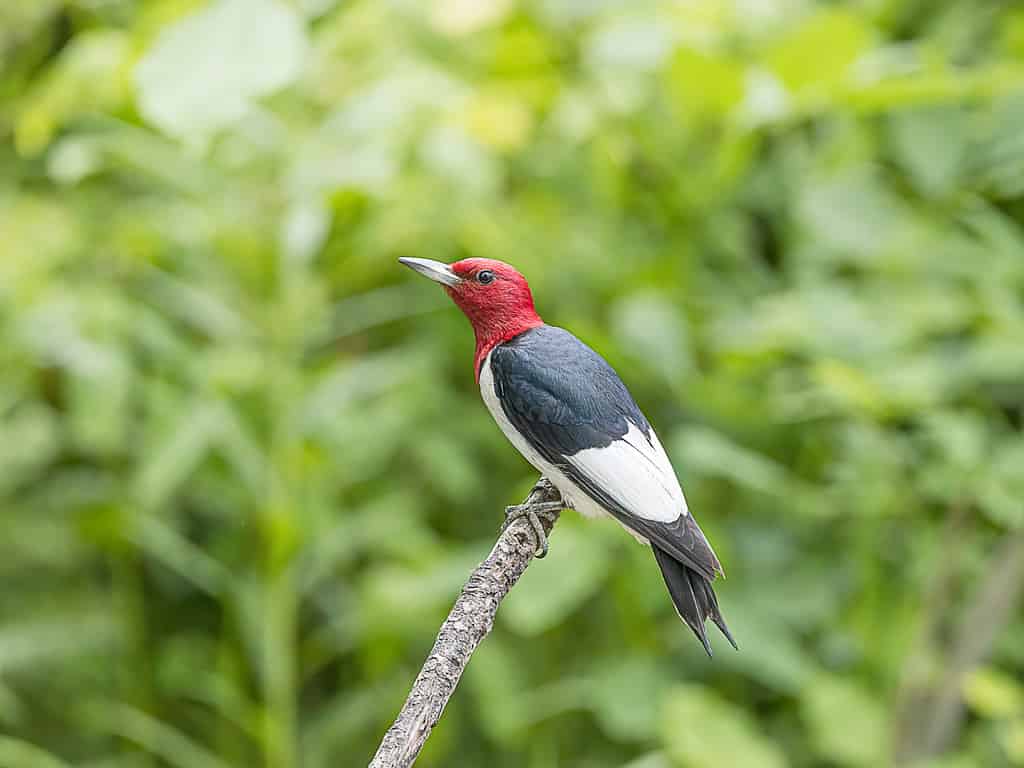
The gorgeous, bold red-headed woodpecker is easy to distinguish from other species. They have bold red heads and black and white bodies, but no stripes or dots like other species. You’ll find these birds in Virginia year-round.
©ilkah/Shutterstock.com
- Scientific name: Melanerpes erythrocephalus
- Life span: 8 to 10 years
- Size: 7.5 to 9.8 inches
- Weight: 2.0 to 3.4 ounces
- Wingspan: 14 to 17 inches
- Status: Least Concern
Perhaps the most well-known woodpeckers in Virginia are the red-headed woodpecker. Admittedly, today’s generation may be a little less familiar with them the generations who had Woody Woodpecker cartoons around. But the birds make their around the state year-round in semi-open country and forests. They may also be found in wetlands or pine savannas.
These birds have bold coloring to help identify them. Bright white bellies and white patches on their black wings and vibrant red heads make them easy to spot among the trees. The medium-sized birds have large round heads and short tails, with slightly short, powerful bills. They are often heard in the trees hammering away looking for insects.
Red-Cockaded Woodpecker

A red-cockaded Woodpecker is harder to spot than other species for a few reasons. First, they’re Endangered and therefore rare. Second, they’re on the smaller size without the bright, bold red of many other woodpecker species. If you’re so lucky, you’re most likely to spot these woodpeckers in Virginia in mature pine forests.
©feathercollector/Shutterstock.com
- Scientific name: Picoides borealis
- Life span: 10 to 12 years
- Size: 7 to 9 inches
- Weight: 2 ounces
- Wingspan: 12 to 15 inches
- Status: Endangered
The endangered red-cockaded woodpecker may be found in Virginia year-round, though finding them is the challenge. The species has been listed endangered since 1970, meaning they’re hard to find anywhere. But the rare lucky person could spot these beauties in mature pine forests with minimal undergrowth.
The robin-sized birds have small, straight bills and a red streak, almost imperceptible, on the males on the upper edge of their cheeks. They have white and black plumage, with bars on their backs. They also have large, white patches on their cheeks, both male and female.
Lewis’s Woodpecker
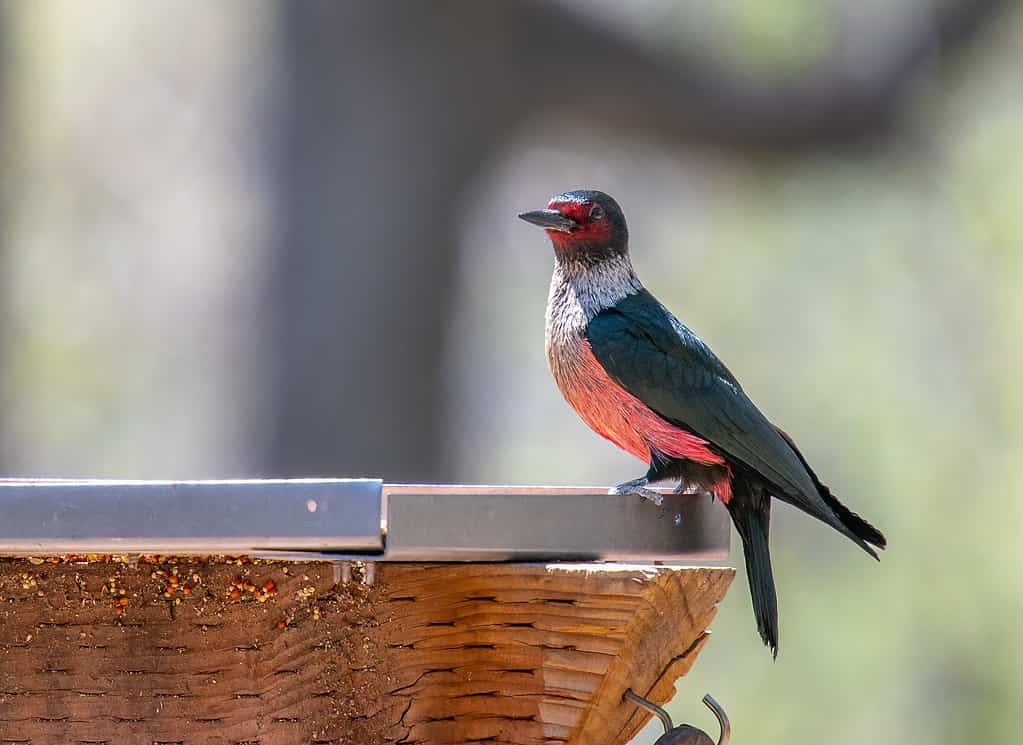
The unusual, brightly colored Lewis’s Woodpecker both looks like other woodpeckers and distinctly doesn’t. The birds don’t frequently make their way into Virginia, but when they do, many folks don’t even recognize them as woodpeckers!
©Gerald DeBoer/iStock via Getty Images
- Scientific name: Melanerpes lewis
- Life span: Unknown
- Size: 10.2 to 11 inches
- Weight: 4.1 ounces
- Wingspan: 19.3 to 20.5 inches
- Status: Unknown due to localized and erratic occurrence, believed to be in decline
Extremely rare sightings of Lewis’s woodpecker in Virginia have been recorded between January and March. So, when it’s wintertime, keep an eye out, in case you’re one of the few and lucky to see these intriguing birds!
The hardy bird has a long tail, long wings, and an elongated body, between the size of a crow and a robin. They have dark red faces, dark green backs, pink bellies, and gray collars. They scatter throughout woodlands, orchards, burned forests, and pine forests at any time of year.
This variety of woodpecker prefers catching insects and bark rather than drilling into wood. They often sit atop a tree, waiting for their flying prey before they launch out to hunt.
How to Attract Woodpeckers to Your Backyard Feeders
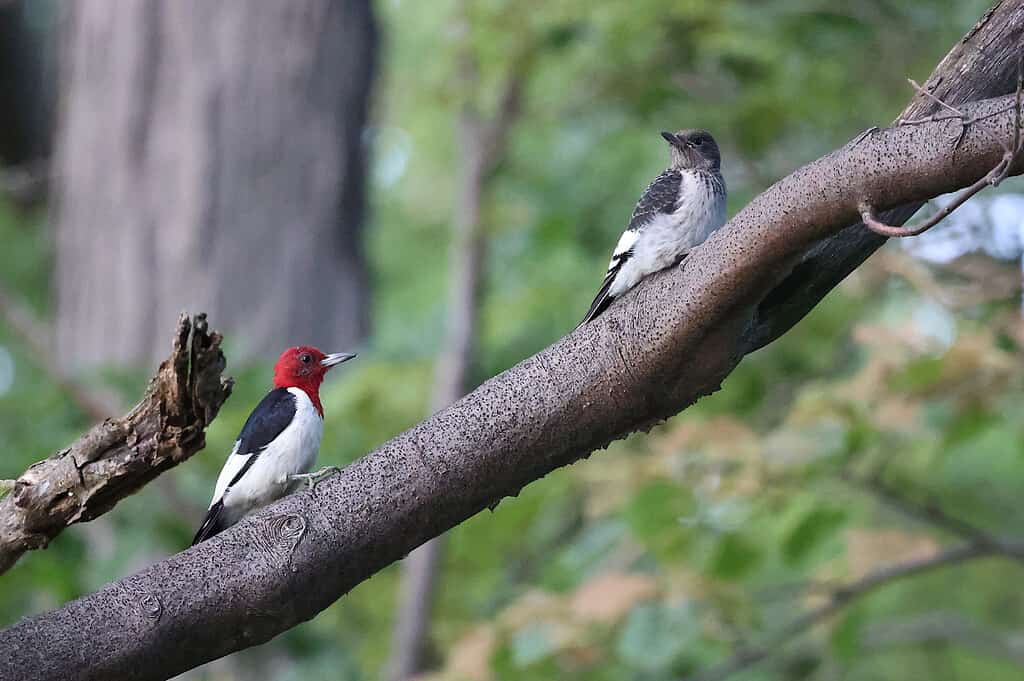
Attract woodpeckers to your backyard with these choice steps, including providing appropriate feed, water, and nesting spaces.
©artiste9999/iStock via Getty Images
Woodpeckers in Virginia love their backyard bird feeders but there are some other things you can do to attract them to the yard.
- Provide the proper woodpecker food in the backyard feeders. They prefer suet and black sunflower seeds, as well as peanut butter feeders in some (species-specific) cases.
- Make sure the suet feeder has a tail prop area to the birds can properly support themselves while feeding. This will draw in even more woodpeckers than chickadees or others in many cases, particularly larger species.
- Leave your dead trees in place. Woodpeckers love pecking at these for insects and larvae for dinner. Plus, it encourages them to hunt here instead of on the house or shed which could be damaged by their pecking.
- Add nesting boxes to the yard. Many woodpecker species use these in Virginia, particularly pileated woodpeckers between May and July.
- Grow native fruit bearing trees in the yard, like tupelo, mountain ash, strawberries, cherries, grapes, and apples. Woodpeckers love these alternative food sources.
- Provide a water feature for the birds to bathe in and drink from.
The photo featured at the top of this post is © Darryl Saffer/ via Getty Images
Thank you for reading! Have some feedback for us? Contact the AZ Animals editorial team.







